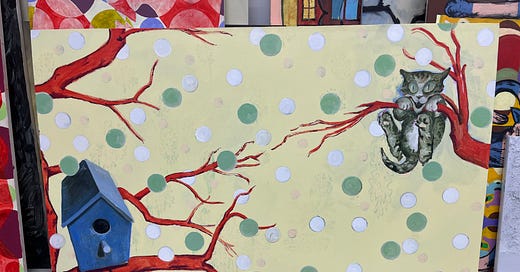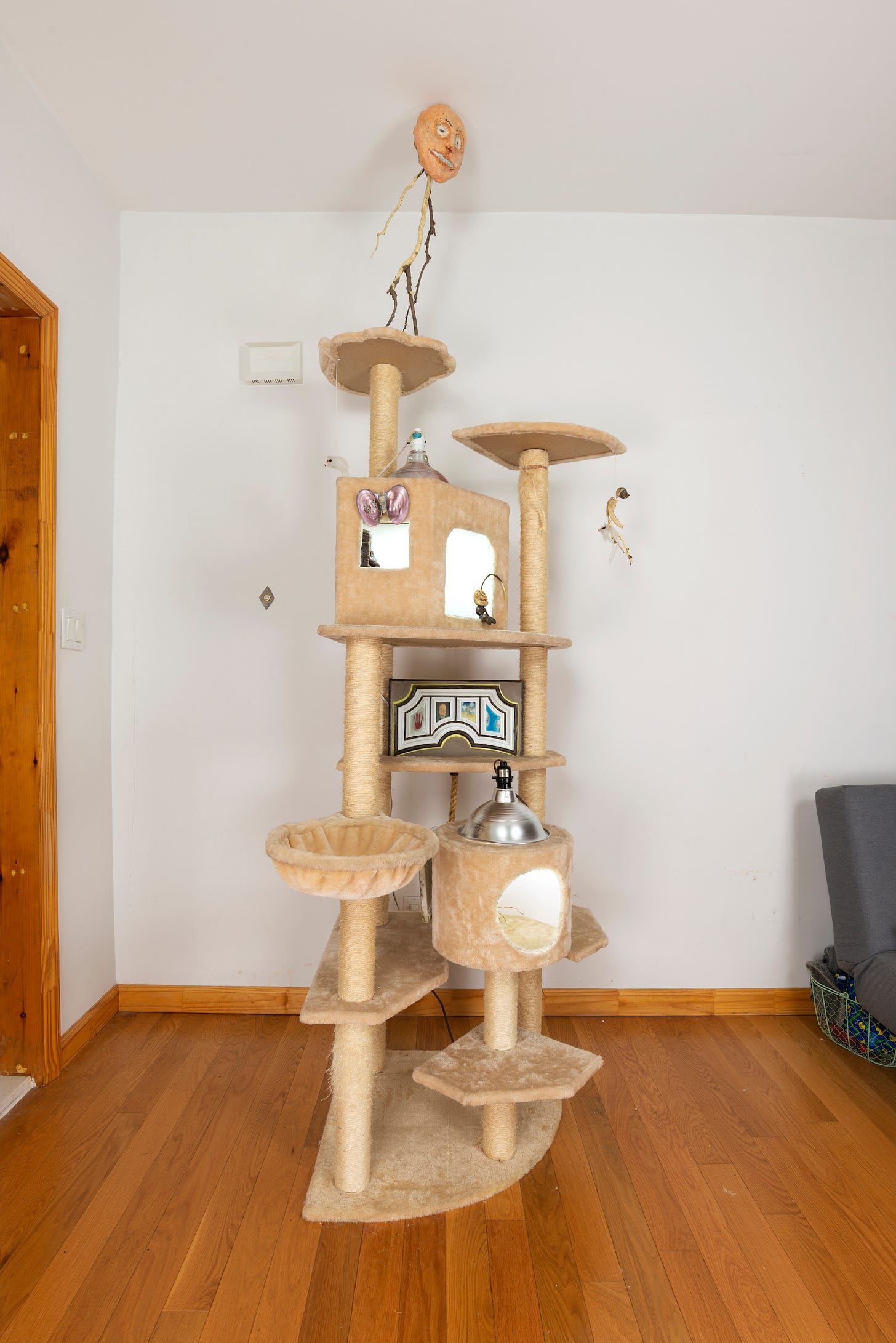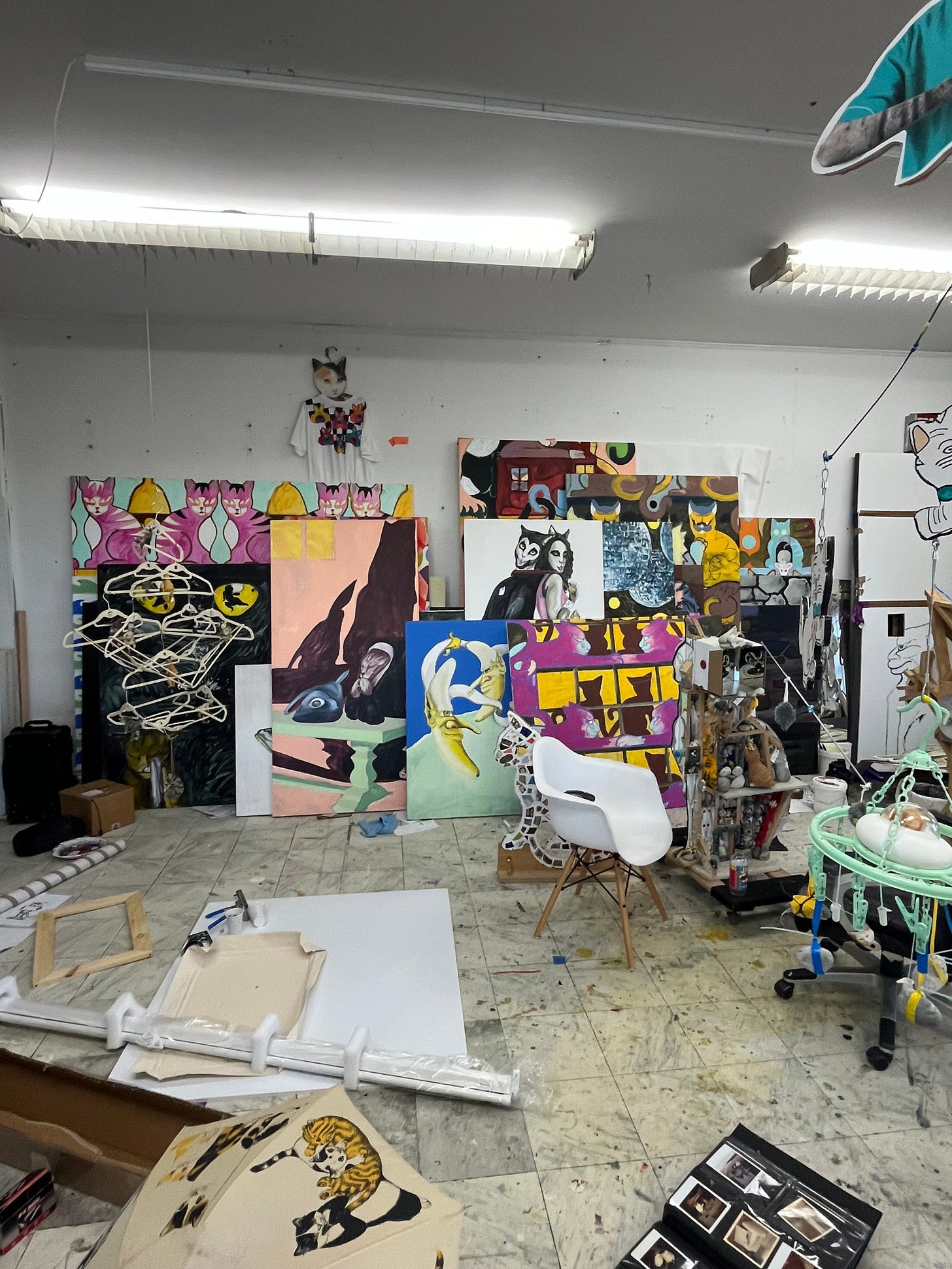A Minute With Philip Hinge
Hi! This is a newsletter about artists I like.
I began acquiring art through some friends who worked in galleries. I started small, working on a limited budget for stuff I could afford. As time passed, my collection grew, and it was exciting to watch many of the artists I'd collected go on to bigger shows and critical acclaim. My goal with this newsletter is to make a digestible resource for anyone interested in artists making excellent (and still affordable!) work whom you haven't heard about... yet.
I first learned about Philip through his gallery Catbox which was around 2020-ish and ended up buying something from him. The gallery is set around his 6 foot tall-ish cat tree and that was something that got me thinking about the creativity of people in showing art. Such a great idea and I’ve recently noticed the artwork Philip has been putting out and love it.
I’m always fascinated/intrigued by the showing art and/or creating and how one balances being a gallerist and artist.
I first came across you through your gallery, catbox, and lately, I have seen some incredible cat paintings of yours, so how did this cat stuff come to be? I’m not a cat person but love your gallery and love those paintings!
PH: The whole endeavor becomes an effective way to drop someone’s guard or create misdirection. If someone hoards cats, it’s ultimately not a problem about “cats” at all. The cats are the symptom of a deeper issue. To boot, the utter pervasiveness of cats in people’s experiences, in art, in pop references, in history, and across cultures, understand that as a the “cat” as a device can hi-jack any narrative or subtext you can imagine. Spirituality, superstition, dumbness, vulnerability, empathy, polarity, mental health, domesticity, even class, it’s all up for grabs. And the form is instantly recognizable, so cat person or not, an instant transmission, subconscious or conscious, is projected to a viewer.
That said, I also have a ton of personal history to pull from. As far back as I can remember there has always been a cat or two in my life. I have a lot of anxiety, and as a kid when it was really bad and I didn’t know how to deal with it, I would try and imagine how much better my life would be as a cat. But I was also acutely aware that my life would be much shorter if I became a cat, so my anxiety persisted, even in my escapist fantasies. When it comes to how I harness cats in my art, the fluidness of the form and the culture around it really sucked me in. You have an endless supply of simulacrum, tchotchkes, and forms to manipulate, so the inventiveness never stops for me.
Are you still running your gallery, how do you balance making work and showing work?
PH: It’s not easy for me to end things, so Catbox is still going, but far less frequently. At its height I was doing 8 shows a year at my apt and a satellite (“catellite”) show domestically or abroad once or twice a year. Covid was the first real blow. That upended the apartment gallery vibe. Coming out of Covid, when Catbox started to normalize, my partner got diagnosed with breast cancer. At that point the apartment was 100 percent dedicated to healing. I moved Catbox to my studio, and it works but doesn’t feel as true to form as when it lives with my cats in the apt.
Cancer changes everything, and it’s been something that will have changed both our lives forever. It’s made my really try and reign in how much energy I rent to other people and projects. Being present to someone going though intensely aggressive treatment taught me I need to keep some energy for myself, or I can’t be any use to anyone. At one point I was running Catbox, darkZone (a space in my parent’s basement in NJ), working the gallery I helped found, AD, doing my own thing, and 2 jobs to make ends meet and keep everything going. By the time I crashed I really crashed and needed to reconfigure my whole life. I spend a lot more time on myself and my own work now, and I’m better for it. That said I will always have some curatorial project going, but it will be a steady stream instead the tidal wave it was before.
Can you talk about your background or how you came to be where you are today?
PH: I grew up drawing and playing in bands and rollerblading. I wasn’t good at school, couldn’t focus or retain much. My first job was dj-ing, running floor supervision, and hosting parties/sesssions at a rollerrink in NJ. I think that explains a lot about me. Art was funny in my upbringing. My parents were super protective and really tried to control what got through the defenses they set up around my sister and me. But tough for them, because we grew up in the 90’s where you couldn’t go to a comic store without seeing ultra-violent and sexually in your face imagery around. When my parents did take my sister and I to a museum, it was always a delicate dance sidestepping any nudity, which sent a lot of confusing signals and made things uncomfortable as possible, so repression ran rampant.
At some point it became clear I wasn’t interested in anything aside from art and my parent’s let me apply to art school. When I got to art-school I had no art historical knowledge outside of some old masters and a trove of fantasy illustrators (Brom/Phil Hale/Frazetta). I ended up getting competitive and tried to make more work than everyone else to try and catch up. I see it now as super misguided an emotionally wasteful time, but that time did teach me the only way for me to get better was by being consistent in making.
Would you be cool to show some pictures of your studio?
PH: Surely, right now there’s a lot going on. I had a show at International Waters last January that taught me to chase every idea I had, which has been incredibly fruitful and has expanded the practice immensely.
How can our readers see/share/support you with these recent paintings? A show soon?
PH: I’ll have a two person show with mega talent, Catherine Mulligan, at General Expenses in Mexico this coming spring. I’ll be in the next issue of Synchron magazine. Aside from that I have a few shows and projects in that horribly stressful, “can’t talk about it yet” phase. As far as support, dialogue and viewership means a lot to me. I always appreciate hearing that people are excited by what I’m doing. I love having people by the studio, it’s always energizing, so I’m always open to visitors, so feel free to get in touch.
What’s the rest of the year look like for ya ?
PH: The rest of the year I’m staying on task and making work as much as I can. I just released a new darkZone show late October, a giant group show that will make a nice segway to a project space I’m aiming to launch early 2025, called, “CHVRCH MOVSE” (my studio is a church annex out in ridgewood, NY and there are some spaces that resonate with my around the building).
Who should we have on next ?
PH: I’m a die-hard Tina Braegger fan. I saw some work of hers online around 2014 or 15 and was instantly enamored. I was lucky enough to work with her on a Catbox in 2018, and we did a show together to close out phase one of darkzone in 2022.
Best music to paint to ?
PH: I’ve made a conscious effort to open-up my musical tastes over the past few years, but I always come back to metal. Metal has a bonkers subgenre game, so you can really find something for any mood. By shuffling the metal genres (folk, black, electronic, operatic, progressive, power, depressive, avante garde, etc) a hypnotic flow develops, which is good for painting. Lately Agalloch, Witherscape, Theatre of Tragedy, Beyond Twilight and Diabolical Masquerade have been on heavy rotation, all heavily recommended.






